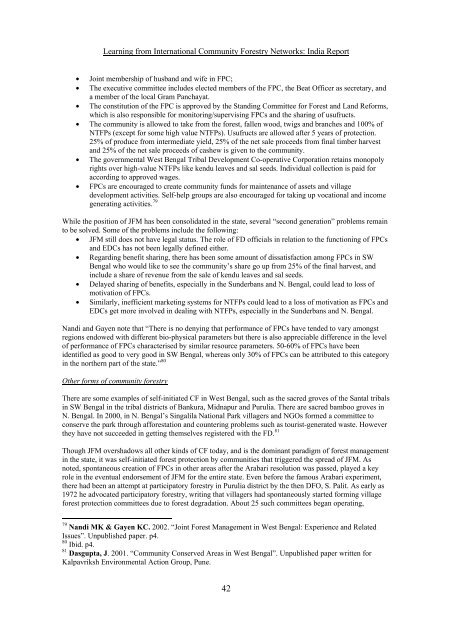Snapshots of International Community Forestry Networks: Country ...
Snapshots of International Community Forestry Networks: Country ...
Snapshots of International Community Forestry Networks: Country ...
Create successful ePaper yourself
Turn your PDF publications into a flip-book with our unique Google optimized e-Paper software.
Learning from <strong>International</strong> <strong>Community</strong> <strong>Forestry</strong> <strong>Networks</strong>: India Report<br />
• Joint membership <strong>of</strong> husband and wife in FPC;<br />
• The executive committee includes elected members <strong>of</strong> the FPC, the Beat Officer as secretary, and<br />
a member <strong>of</strong> the local Gram Panchayat.<br />
• The constitution <strong>of</strong> the FPC is approved by the Standing Committee for Forest and Land Reforms,<br />
which is also responsible for monitoring/supervising FPCs and the sharing <strong>of</strong> usufructs.<br />
• The community is allowed to take from the forest, fallen wood, twigs and branches and 100% <strong>of</strong><br />
NTFPs (except for some high value NTFPs). Usufructs are allowed after 5 years <strong>of</strong> protection.<br />
25% <strong>of</strong> produce from intermediate yield, 25% <strong>of</strong> the net sale proceeds from final timber harvest<br />
and 25% <strong>of</strong> the net sale proceeds <strong>of</strong> cashew is given to the community.<br />
• The governmental West Bengal Tribal Development Co-operative Corporation retains monopoly<br />
rights over high-value NTFPs like kendu leaves and sal seeds. Individual collection is paid for<br />
according to approved wages.<br />
• FPCs are encouraged to create community funds for maintenance <strong>of</strong> assets and village<br />
development activities. Self-help groups are also encouraged for taking up vocational and income<br />
generating activities. 79<br />
While the position <strong>of</strong> JFM has been consolidated in the state, several “second generation” problems remain<br />
to be solved. Some <strong>of</strong> the problems include the following:<br />
• JFM still does not have legal status. The role <strong>of</strong> FD <strong>of</strong>ficials in relation to the functioning <strong>of</strong> FPCs<br />
and EDCs has not been legally defined either.<br />
• Regarding benefit sharing, there has been some amount <strong>of</strong> dissatisfaction among FPCs in SW<br />
Bengal who would like to see the community’s share go up from 25% <strong>of</strong> the final harvest, and<br />
include a share <strong>of</strong> revenue from the sale <strong>of</strong> kendu leaves and sal seeds.<br />
• Delayed sharing <strong>of</strong> benefits, especially in the Sunderbans and N. Bengal, could lead to loss <strong>of</strong><br />
motivation <strong>of</strong> FPCs.<br />
• Similarly, inefficient marketing systems for NTFPs could lead to a loss <strong>of</strong> motivation as FPCs and<br />
EDCs get more involved in dealing with NTFPs, especially in the Sunderbans and N. Bengal.<br />
Nandi and Gayen note that “There is no denying that performance <strong>of</strong> FPCs have tended to vary amongst<br />
regions endowed with different bio-physical parameters but there is also appreciable difference in the level<br />
<strong>of</strong> performance <strong>of</strong> FPCs characterised by similar resource parameters. 50-60% <strong>of</strong> FPCs have been<br />
identified as good to very good in SW Bengal, whereas only 30% <strong>of</strong> FPCs can be attributed to this category<br />
in the northern part <strong>of</strong> the state.” 80<br />
Other forms <strong>of</strong> community forestry<br />
There are some examples <strong>of</strong> self-initiated CF in West Bengal, such as the sacred groves <strong>of</strong> the Santal tribals<br />
in SW Bengal in the tribal districts <strong>of</strong> Bankura, Midnapur and Purulia. There are sacred bamboo groves in<br />
N. Bengal. In 2000, in N. Bengal’s Singalila National Park villagers and NGOs formed a committee to<br />
conserve the park through afforestation and countering problems such as tourist-generated waste. However<br />
they have not succeeded in getting themselves registered with the FD. 81<br />
Though JFM overshadows all other kinds <strong>of</strong> CF today, and is the dominant paradigm <strong>of</strong> forest management<br />
in the state, it was self-initiated forest protection by communities that triggered the spread <strong>of</strong> JFM. As<br />
noted, spontaneous creation <strong>of</strong> FPCs in other areas after the Arabari resolution was passed, played a key<br />
role in the eventual endorsement <strong>of</strong> JFM for the entire state. Even before the famous Arabari experiment,<br />
there had been an attempt at participatory forestry in Purulia district by the then DFO, S. Palit. As early as<br />
1972 he advocated participatory forestry, writing that villagers had spontaneously started forming village<br />
forest protection committees due to forest degradation. About 25 such committees began operating,<br />
79<br />
Nandi MK & Gayen KC. 2002. “Joint Forest Management in West Bengal: Experience and Related<br />
Issues”. Unpublished paper. p4.<br />
80<br />
Ibid. p4.<br />
81<br />
Dasgupta, J. 2001. “<strong>Community</strong> Conserved Areas in West Bengal”. Unpublished paper written for<br />
Kalpavriksh Environmental Action Group, Pune.<br />
42

















![CynefinFramework final [Read-Only]](https://img.yumpu.com/19017304/1/190x135/cynefinframework-final-read-only.jpg?quality=85)